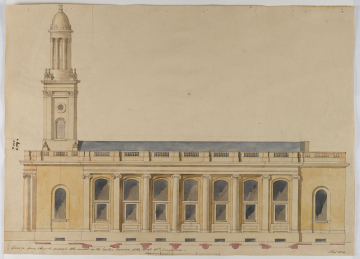
Browse
Reference number
Purpose
Aspect
The elevation shows the entrance on the left-hand side with an Ionic column in profile, which is supporting the entablature above. Along the side are nine bays, with the first and ninth bays having arched windows within relieving arches. The second to eighth bays have transomed windows: round headed above and square at the bottom with panels beneath. These are aligned with half submerged squared windows at the vault level. The windows are articulated by Ionic pilasters on the second and eighth bays and engaged Ionic columns on the third to seventh bays. The columns support a fascia and cornice running above the second to eighth bays. At roof level is a balustrade punctuated by sets of turned balusters. On the left-hand side is the rectangular portion of a tower which has caps at the bottom corners, and has a shuttered louvre at the bottom, a roundel above and a panel above that. The architrave is supported by Corinthian pilasters, and there are pinecone caps on the top of the architrave at each corner. Above is the cylindrical portion of the tower, with a lancet window, and the architrave is supported by engaged Corinthian columns. Above is a dome with antefixes attached around its base, and surmounted by the bottom portion of a finial. To the right-hand side of the tower is a pitched roof running to just beyond the eighth bay. Pencil is used for centring
Plan of the side of the church showing nine bays and the arrangement of the engaged columns and pilasters. The plan is aligned with an elevation above
The elevation shows the (south) side of a nine-bay church . On the left there is the front porch with an Ionic column in profile.There are square-topped windows at vault level. The first and eighth bays above have large arch-topped windows, whilst the second to seventh bays have square-topped bottom windows and arch-topped windows above. They are framed by giant Ionic pilasters with a stone cornice. Above is a stone balustrade. The roof is long and flat. The tower is identical to that seen in SM 54/2/11, 12
Scale
Inscribed
Signed and dated
- November 1824
Novr. 1824
Medium and dimensions
Hand
Level
Sir John Soane's collection includes some 30,000 architectural, design and topographical drawings which is a very important resource for scholars worldwide. His was the first architect’s collection to attempt to preserve the best in design for the architectural profession in the future, and it did so by assembling as exemplars surviving drawings by great Renaissance masters and by the leading architects in Britain in the 17th and 18th centuries and his near contemporaries such as Sir William Chambers, Robert Adam and George Dance the Younger. These drawings sit side by side with 9,000 drawings in Soane’s own hand or those of the pupils in his office, covering his early work as a student, his time in Italy and the drawings produced in the course of his architectural practice from 1780 until the 1830s.
Browse (via the vertical menu to the left) and search results for Drawings include a mixture of Concise catalogue records – drawn from an outline list of the collection – and fuller records where drawings have been catalogued in more detail (an ongoing process).

